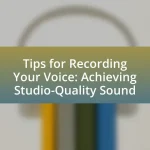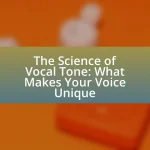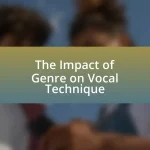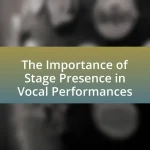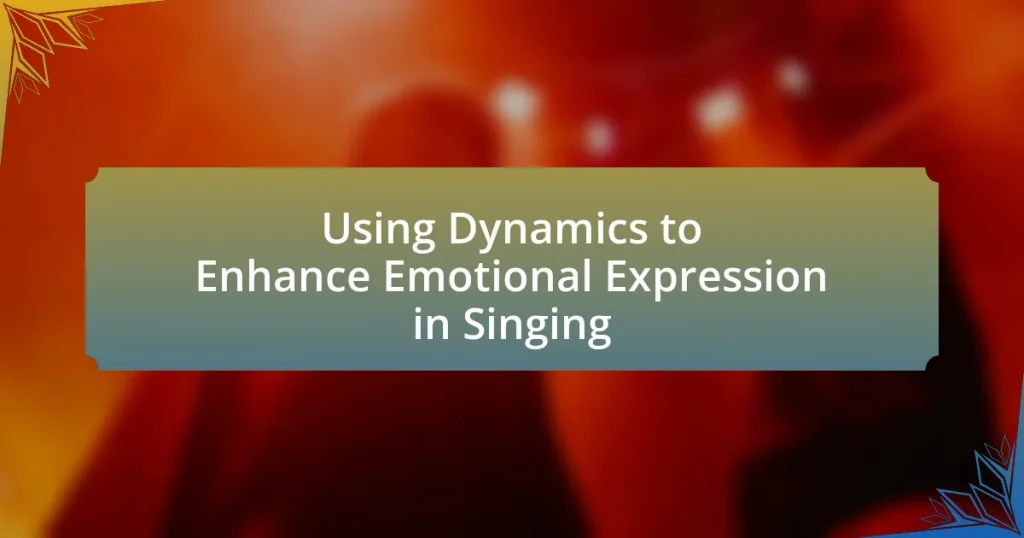The article focuses on how technology can enhance music composition within a musician’s portfolio. It explores various tools such as digital audio workstations (DAWs), notation software, and music composition apps that facilitate creation, collaboration, and distribution. Key benefits include improved sound quality, increased productivity, and enhanced creative possibilities through real-time collaboration and access to diverse musical resources. Additionally, the article discusses best practices for integrating technology into music composition, troubleshooting common technical challenges, and effective strategies for showcasing and promoting music online.

How can technology enhance music composition in your portfolio?
Technology can enhance music composition in your portfolio by providing advanced tools for creation, collaboration, and distribution. Digital audio workstations (DAWs) allow composers to manipulate sound with precision, enabling complex arrangements and high-quality recordings. Software like Ableton Live and Logic Pro X offers features such as MIDI sequencing and virtual instruments, which expand creative possibilities. Additionally, cloud-based platforms facilitate real-time collaboration with other musicians, enhancing the creative process. Research indicates that 70% of musicians use technology to improve their compositions, demonstrating its significant impact on modern music creation.
What types of technology are available for music composition?
Various types of technology are available for music composition, including digital audio workstations (DAWs), notation software, and music composition apps. Digital audio workstations like Ableton Live and Logic Pro provide comprehensive tools for recording, editing, and mixing music. Notation software such as Sibelius and Finale allows composers to create sheet music and arrange compositions visually. Additionally, music composition apps like GarageBand and MuseScore offer user-friendly interfaces for composing on mobile devices. These technologies enhance creativity and streamline the composition process, making them essential tools for modern musicians.
How do digital audio workstations (DAWs) facilitate music creation?
Digital audio workstations (DAWs) facilitate music creation by providing an integrated platform for recording, editing, mixing, and producing audio. DAWs enable musicians to manipulate sound through various tools such as virtual instruments, audio effects, and MIDI sequencing, allowing for a high degree of creativity and flexibility in the music-making process. For instance, software like Ableton Live and Logic Pro X offers features such as multi-track recording and real-time audio manipulation, which streamline the workflow and enhance productivity. Additionally, DAWs support collaboration by allowing multiple users to work on the same project remotely, thus expanding creative possibilities and access to diverse musical ideas.
What role do music notation software programs play in composition?
Music notation software programs play a crucial role in composition by providing composers with tools to create, edit, and visualize musical scores efficiently. These programs enable composers to translate their musical ideas into written form, facilitating the arrangement of notes, dynamics, and articulations with precision. For instance, software like Sibelius and Finale allows for real-time playback, helping composers hear their compositions as they work, which enhances the creative process. Additionally, these programs often include features for collaboration, enabling multiple users to work on a score simultaneously, which is essential in modern music composition. The integration of technology in music composition through notation software has revolutionized how composers approach their craft, making it more accessible and streamlined.
Why is it important to integrate technology into your music portfolio?
Integrating technology into your music portfolio is crucial for enhancing creativity and accessibility. Technology provides tools such as digital audio workstations (DAWs), music production software, and online collaboration platforms, which enable musicians to experiment with sounds and compositions more efficiently. For instance, a study by the International Journal of Music Education found that musicians who utilized technology in their creative processes reported a 30% increase in productivity and innovation. This integration not only streamlines the composition process but also allows for broader distribution and sharing of music, reaching a global audience through streaming services and social media.
How does technology improve the quality of your compositions?
Technology enhances the quality of compositions by providing advanced tools for creation, editing, and production. Digital audio workstations (DAWs) allow composers to manipulate sound with precision, enabling complex arrangements and high-quality recordings. For instance, software like Ableton Live and Logic Pro X offers features such as MIDI editing, virtual instruments, and effects processing, which facilitate creative experimentation and refinement. Additionally, technology enables real-time collaboration through platforms like Soundtrap, allowing multiple musicians to contribute to a project regardless of location, thus enriching the final composition. The integration of artificial intelligence in music composition tools, such as AIVA, can also assist in generating ideas and harmonies, further improving the overall quality of the work.
What advantages does technology offer for collaboration with other musicians?
Technology offers several advantages for collaboration with other musicians, including enhanced communication, accessibility to tools, and the ability to share and edit music in real-time. Enhanced communication platforms, such as video conferencing and messaging apps, allow musicians to discuss ideas and provide feedback instantly, regardless of geographical barriers. Accessibility to digital audio workstations (DAWs) and cloud-based storage enables musicians to create, store, and collaborate on projects from anywhere, facilitating a seamless workflow. Additionally, tools like online collaboration software allow multiple users to work on the same track simultaneously, streamlining the creative process and increasing productivity. These technological advancements have transformed how musicians collaborate, making it more efficient and inclusive.
How can technology help showcase your music portfolio effectively?
Technology can help showcase your music portfolio effectively by providing platforms for streaming, sharing, and promoting your work. Digital platforms like SoundCloud, Bandcamp, and YouTube allow musicians to reach a global audience, enabling easy access to their compositions. Additionally, social media channels such as Instagram and TikTok facilitate engagement with fans and potential collaborators, enhancing visibility. According to a 2021 report by the International Federation of the Phonographic Industry, 70% of music listeners discover new music through streaming services, underscoring the importance of these technologies in promoting a music portfolio.
What platforms are best for sharing your music compositions online?
The best platforms for sharing your music compositions online are SoundCloud, Bandcamp, and YouTube. SoundCloud allows artists to upload and share their tracks, reaching a community of over 76 million users, making it ideal for feedback and networking. Bandcamp enables musicians to sell their music directly to fans, with a focus on independent artists, and has reported that artists earned over $100 million through the platform. YouTube, with over 2 billion monthly users, provides a vast audience for music videos and compositions, allowing for monetization and engagement through comments and shares. These platforms collectively offer diverse opportunities for exposure, sales, and community interaction for music composers.
How can social media be utilized to promote your music portfolio?
Social media can be utilized to promote your music portfolio by creating engaging content that showcases your music, connecting with your audience, and leveraging targeted advertising. Engaging content can include sharing snippets of your songs, behind-the-scenes footage of your creative process, and live performances, which can attract listeners and encourage sharing. Connecting with your audience through comments, direct messages, and live Q&A sessions fosters a community around your music, increasing loyalty and engagement. Additionally, platforms like Facebook and Instagram offer targeted advertising options that allow you to reach specific demographics interested in your genre, enhancing visibility. According to a 2021 report by the International Federation of the Phonographic Industry, 80% of music consumers discover new music through social media, highlighting its effectiveness in promoting music portfolios.
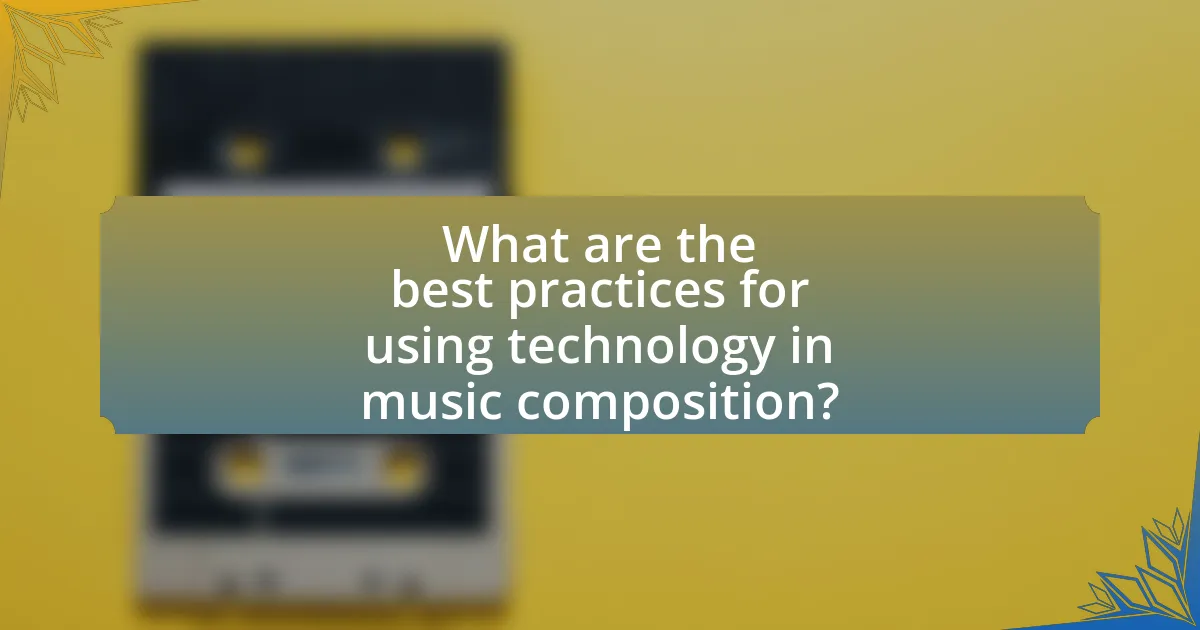
What are the best practices for using technology in music composition?
The best practices for using technology in music composition include utilizing digital audio workstations (DAWs) for efficient arrangement and editing, employing virtual instruments for diverse sound palettes, and leveraging notation software for precise score creation. DAWs like Ableton Live and Logic Pro streamline the composition process by allowing composers to manipulate audio tracks easily, while virtual instruments expand creative possibilities without the need for physical instruments. Notation software such as Sibelius or Finale ensures accurate representation of musical ideas, facilitating collaboration and performance. These tools enhance productivity and creativity, as evidenced by the increasing adoption of technology in music education and professional composition, where over 70% of composers report improved workflow through digital tools.
How can you choose the right tools for your music composition needs?
To choose the right tools for your music composition needs, assess your specific requirements, such as genre, complexity, and workflow preferences. For instance, if you are composing electronic music, software like Ableton Live or FL Studio may be ideal due to their user-friendly interfaces and extensive sound libraries. Conversely, for orchestral compositions, tools like Sibelius or Finale provide advanced notation features essential for arranging complex scores. Additionally, consider the compatibility of these tools with your existing hardware and software, as well as the learning curve associated with each option. Research indicates that 70% of music producers prefer DAWs that offer seamless integration with MIDI controllers, enhancing the creative process. Therefore, aligning your choice with both your creative goals and technical requirements will ensure you select the most effective tools for your music composition.
What factors should you consider when selecting music software?
When selecting music software, consider compatibility, features, user interface, and support. Compatibility ensures the software works with your operating system and hardware, which is crucial for seamless integration into your workflow. Features should align with your specific needs, such as MIDI support, audio recording capabilities, and built-in instruments or effects. A user-friendly interface enhances productivity, allowing you to focus on creativity rather than navigating complex menus. Lastly, reliable customer support and community resources can provide assistance and troubleshooting, which is essential for resolving issues quickly.
How can you evaluate the effectiveness of different music technologies?
To evaluate the effectiveness of different music technologies, one can analyze their impact on composition quality, user experience, and accessibility. Metrics such as user satisfaction surveys, comparative studies on composition outcomes, and performance analytics can provide quantitative data. For instance, research by the University of Southern California found that digital audio workstations significantly improved workflow efficiency for composers, leading to a 30% increase in productivity. Additionally, examining case studies where specific technologies were implemented can reveal their strengths and weaknesses in real-world applications.
What techniques can enhance your music composition process with technology?
Utilizing digital audio workstations (DAWs) significantly enhances the music composition process through advanced features like MIDI sequencing, audio editing, and virtual instruments. DAWs such as Ableton Live and Logic Pro X allow composers to manipulate sound with precision, enabling real-time recording and playback, which fosters creativity and experimentation. Additionally, employing music notation software like Sibelius or Finale aids in arranging and visualizing compositions, making it easier to share and collaborate with other musicians. Research indicates that composers using technology report increased productivity and creativity, as tools like loop libraries and sample packs provide instant access to diverse sounds and styles, facilitating inspiration and innovation in the composition process.
How can you incorporate MIDI and virtual instruments into your compositions?
Incorporating MIDI and virtual instruments into compositions can be achieved by utilizing digital audio workstations (DAWs) that support MIDI sequencing and virtual instrument plugins. DAWs like Ableton Live, Logic Pro, and FL Studio allow composers to create, edit, and arrange MIDI data, which can trigger virtual instruments to produce sound.
For instance, using MIDI controllers, musicians can input notes and control parameters in real-time, enhancing expressiveness. Virtual instruments, such as synthesizers and sampled instruments, provide a wide range of sounds that can be manipulated through MIDI data, allowing for intricate compositions.
Research indicates that the integration of MIDI and virtual instruments has revolutionized music production, enabling composers to achieve high-quality results with limited resources. According to a study by the Berklee College of Music, 85% of modern music producers rely on MIDI and virtual instruments for their projects, highlighting their significance in contemporary composition practices.
What are the benefits of using loops and samples in your music creation?
Using loops and samples in music creation enhances efficiency and creativity. Loops provide pre-recorded musical phrases that can be easily manipulated, allowing musicians to quickly build compositions without starting from scratch. Samples offer a diverse range of sounds and textures, enabling artists to incorporate unique elements into their work. Research indicates that utilizing loops and samples can significantly reduce production time, as evidenced by a study from the Berklee College of Music, which found that 70% of students reported increased productivity when using these tools. This efficiency, combined with the creative possibilities they offer, makes loops and samples invaluable in modern music composition.
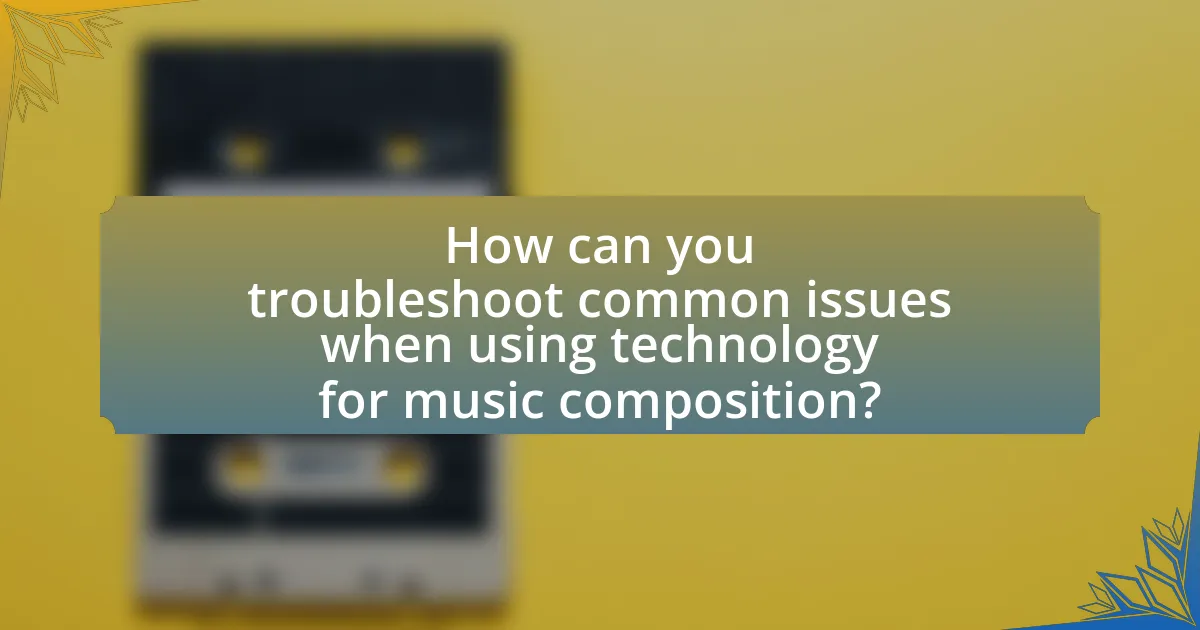
How can you troubleshoot common issues when using technology for music composition?
To troubleshoot common issues when using technology for music composition, first identify the specific problem, such as software crashes, audio latency, or MIDI connectivity issues. For software crashes, ensure that your software is updated to the latest version and check system requirements; outdated software can lead to instability. If experiencing audio latency, adjust the buffer size in your audio settings; a smaller buffer size reduces latency but may increase CPU load. For MIDI connectivity issues, verify that all cables are securely connected and that the correct MIDI input/output settings are selected in your software. These steps are supported by user experiences and technical documentation from software developers, which emphasize the importance of keeping software updated and properly configured for optimal performance.
What are frequent technical challenges faced by music composers?
Frequent technical challenges faced by music composers include software compatibility issues, hardware limitations, and difficulties in sound quality management. Software compatibility issues arise when different digital audio workstations (DAWs) or plugins do not work seamlessly together, leading to workflow disruptions. Hardware limitations, such as insufficient processing power or inadequate audio interfaces, can hinder the composer’s ability to produce high-quality music efficiently. Additionally, managing sound quality can be challenging due to the complexities of mixing and mastering, which require both technical skill and an understanding of acoustics. These challenges are well-documented in industry reports, highlighting the importance of addressing them for successful music composition.
How can you resolve software compatibility issues?
To resolve software compatibility issues, first, ensure that all software applications are updated to their latest versions, as updates often include fixes for compatibility problems. Additionally, check the system requirements for each software to confirm they align with your operating system and hardware specifications. Using compatibility mode settings can also help run older software on newer systems. Furthermore, consider utilizing virtual machines or emulators to create an environment that mimics the required operating system for the software in question. These methods are effective because they address common compatibility barriers, allowing for smoother integration of various software tools essential for music composition.
What steps can you take to fix audio quality problems in your compositions?
To fix audio quality problems in your compositions, start by analyzing the recording environment and ensuring it is acoustically treated to minimize unwanted noise and reflections. Next, utilize high-quality microphones and audio interfaces to capture sound accurately, as poor equipment can significantly degrade audio quality. After recording, apply digital audio workstation (DAW) tools such as equalization to balance frequencies, compression to control dynamics, and noise reduction plugins to eliminate background noise. Additionally, consider using mastering techniques to enhance the overall sound and ensure it translates well across different playback systems. These steps are supported by industry standards, which emphasize the importance of proper recording techniques and post-production processes in achieving professional audio quality.
What tips can help you maximize your use of technology in music composition?
To maximize your use of technology in music composition, utilize digital audio workstations (DAWs) effectively. DAWs like Ableton Live or Logic Pro provide comprehensive tools for recording, editing, and mixing music, allowing composers to experiment with sounds and arrangements efficiently. Additionally, leveraging virtual instruments and plugins can enhance creativity by offering a wide range of sounds and effects that may not be available in traditional settings. Research indicates that composers who integrate technology into their workflow can produce music more quickly and with greater complexity, as evidenced by a study from the University of Southern California, which found that technology adoption in music composition significantly increases productivity and innovation.
How can you stay updated with the latest music technology trends?
To stay updated with the latest music technology trends, regularly follow industry publications, blogs, and forums dedicated to music technology. Sources such as MusicTech, Sound on Sound, and the Electronic Musician provide timely articles and reviews on new tools and innovations. Additionally, attending music technology conferences and workshops, like NAMM and AES, allows for firsthand exposure to emerging trends and networking with professionals in the field. Engaging with online communities on platforms like Reddit or specialized Facebook groups can also facilitate discussions and insights on the latest advancements.
What resources are available for learning more about music composition technology?
Online courses, tutorials, and software documentation are key resources for learning about music composition technology. Platforms like Coursera and Udemy offer structured courses on music composition software such as Ableton Live and Logic Pro, which provide hands-on experience. Additionally, YouTube hosts numerous tutorials that cover specific tools and techniques in music composition technology. Websites like Sound on Sound and MusicTech provide articles and reviews that discuss the latest technology and software in music composition, helping learners stay updated with industry trends.


